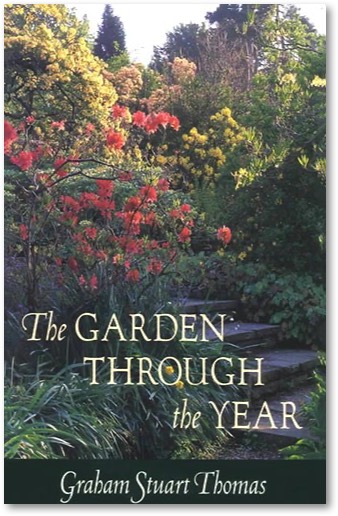
Musings » The Year in Gardening – a critique


Following the year in the garden is a well-worn cliché, a capacious umbrella covering many separate fragments to make a whole greater than the sum of its parts. A number of very gifted garden writers have either done this themselves or let their publishers do it for them. Graham Stuart Thomas, Christopher Lloyd, and Elizabeth Lawrence come to mind very quickly. Vita Sackville-West was the queen of this group yet her work was not collected together by her daughter in law until very late.
There is nothing inherently wrong with the concept beyond a certain repetitiousness. The insights and observations of a fine horticultural mind do not lose anything by being repeated but neither is anything taken forward. In their defense one could argue that some truths about nature and the garden are eternal and need to be recounted time and again to make an impression on the widest possible audience.
In most cases the articles and chapters are recycled from previous work in a newspaper or magazine. Christopher Lloyd wrote a weekly article for the newspaper “The Guardian” for many years. He also wrote a wonderful column for “Country Life” very frequently. “The Guardian” asked the distinguished garden writer Beth Chatto to choose representative pieces and put them together in Cuttings: a year in the garden with Christopher Lloyd. Historiography is the term used for the actual narration and writing of history. What can we call horticultural writing: hortography? This is not a very euphonious word but it will serve the purpose. Unlike the recording of scientific work in which every effort is made to remove any subjective element from the writing every writer has his or her “voice”. This is what we respond to when we read something they have written. This is equally true for fiction or non-fiction.
Lloyd’s voice was tart, and crisp with a mordant wit. One would know who the author was if the paragraphs were read aloud by another person without disclosing the name of the writer.
Miss Lawrence, for all her Southern upbringing, was also firm and taut, nothing fluffy or glossed over. She held very decided opinions and did not mind who knew it. Honeysuckle was a plant she did not like.
Graham Stuart Thomas clearly wrote The Garden Through The Year (2002) himself. There is nothing warmed over about it. It is not widely known that he was also a gifted artist, drawing and painting the flowers in his garden over many years. The book is very clearly organized by month and by repeating categories of plant: trees noted for their foliage, blossom, bark and berries; shrubs, climbers, bulbs and other herbaceous plants. It is illustrated both by Thomas’ own line drawings and by handsome photographs. The production is exceptionally lavish,with the colored images on the same page as the description and not relegated to a separate signature.
Thomas’ writing is quiet and methodical. His encyclopedic knowledge of myriad plants shines through, telling us things we may have observed without realizing it or had not known at all. Winter is the most difficult time for gardens but he makes short work of that. In January, the pink stems of young dogwood offer much needed color. He advises coppicing the small trees to make as many shoots come up at the right time. These are even more beautiful when set against the bright green of Kerria japonica bark and the dull grey of willow.
February brings new gems. We so often forget the delicious fragrance of Daphne. Thomas is very clear about his preferences too. The tulip has its proper proportions and he does not care for the ‘Parrot’ hybrids, but enjoys many others.
It is possible to follow his suggestions without spending a fortune. The essential ingredient is information.

